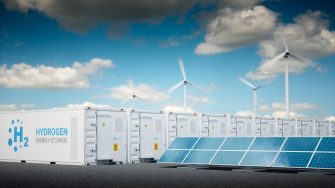Clean Fuels at UNSW
Striving to drive down the production cost of renewable hydrogen to below $2/kg.
Striving to drive down the production cost of renewable hydrogen to below $2/kg.

UNSW is striving to help Australia achieve its net zero targets by driving down clean fuel costs and leading the hydrogen economy.
In line with the International Energy Agency’s projections, we expect hydrogen to contribute 6% to our global emissions reduction goals. We aim to reach this by driving down the production cost of renewable hydrogen to below $2/kg, beating the equivalent fossil-based fuels to decarbonise hard-to-abate sectors. By driving down the cost of local production of clean fuel, we will help position Australia as a renewable energy powerhouse, exporting green fuels and commodities. To achieve this goal, we are focused on research and development in three key areas:
UNSW’s Particle and Catalysis Research Group leads the ARC Industrial Training Centre for the Global Hydrogen Economy (GlobH2E), which is an international consortium of research institutions, industry partners, government agencies and hydrogen start-ups. The vision for GlobH2E is to support innovative, cost-effective hydrogen technologies, combined with advanced business skills, to facilitate and support Australia’s transformation into a world-leading hydrogen powerhouse. GlobH2E will support the fledgling industry and the professionals who will lead it, through quality training and expertise.
A major challenge facing large-scale renewable hydrogen production is the cost and sustainability of electrolysis. While the International Energy Agency hopes that economies of scale will drive down these costs, UNSW is investigating new technologies that can achieve step changes in efficiency and productivity. Many of these new technologies are exploring ways to directly harness solar energy to produce hydrogen and its derivatives (including ammonia, green chemical feedstocks and fuels), known as “Solar to X”. UNSW has developed a strong pipeline of early-stage IP in this space:
Early research has shown high promise for harnessing the full solar energy spectrum to enhance water splitting for hydrogen production. The impetus is now to direct strategic investment towards these nascent technologies as a commercial reality.